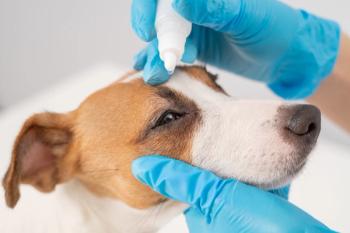
NCSU'S Turtle Rescue Team Gives Students A Walk On The Wild Side
The NCSU College of Veterinary Medicine’s Turtle Rescue Team is providing a unique opportunity for veterinary students with an interest in exotic medicine as the team works on saving the lives of 500 wild reptiles annually.
In late October, Kent Passingham was walking around his father’s farm in Onslow County, NC, when he spotted a yellow rat snake with a huge bulge expanding its middle. An aquatic animal medicine technician at the NCSU College of Veterinary Medicine in Raleigh, Passingham, knew immediately that the snake had swallowed a golf ball thinking that it was an egg.
Passingham gently captured the ailing animal and brought it to the university’s Turtle Rescue Team, for whom he is staff supervisor. There, fourth-year veterinary student Scott Hammer, assisted by third-year student John Griffioen, surgically removed the golf ball. “We’re going to start tube feeding him this week,” Griffioen noted recently as he examined the snake’s surgical incision. “We’ll start him on a liquid diet to make sure the sutures hold before we give him live prey.”
The Turtle Rescue Team is unique to NCSU, and sees more than 500 wild reptiles a year. Of that number, around 95% are turtles, 3% are snakes, 1% are lizards and 1% are amphibians, reported advisor Greg Lewbart, MS, VMD, Dipl. ACZM, Professor of Aquatic Animal Medicine at the NCSU College of Veterinary Medicine.
Dr. Lewbart joined NCSU in 1993, and quickly became the “go-to guy” when a member of the public brought in an injured reptile. He began enlisting students with an interest in reptiles and amphibians and formally established the Turtle Rescue Team in 1996 with money donated by Linda Henis, a licensed rehabilitator with whom Lewbart had worked closely. Today, the program’s annual budget is around $9,000, funded by public donations and student-run fund-raising efforts.
Since its debut, the Turtle Rescue Team has treated more than 4,000 reptiles and amphibians, releasing the vast majority back into the wild. Those unable to survive outside are given permanent homes among local rehabilitators, museums and aquariums, Lewbart said.
The Turtle Rescue Team provides a unique opportunity for veterinary students with an interest in exotic medicine. Griffioen came to NCSU for its zoological medicine program, and joined the Turtle Rescue Team as a volunteer. “A lot of the upperclassmen talked about how great the program was, so I got involved and started treating,” he said.
The next year, Griffioen was approached by team president Rebecca Drapp to become its rehabilitation coordinator, and in 2016 he was designated president. “The Turtle Rescue Team is a really cool opportunity to get some primary case management where we’re the ones designing the treatment plans,” he noted. “We have oversight but we get to make the treatment plans through the physical exam and follow the case. It’s an invaluable educational opportunity.”
Second-year student Kassie Martinez agrees. Like Griffioen, she has a strong interest in exotics and jumped at the chance to hone her skills. “I think the Turtle Rescue Team is one of the highlights of NC State’s veterinary curriculum,” she said. “It provides a great opportunity to work with live patients, as well as with the general public. It’s cooperative across all grade levels in the veterinary school, and Dr. Lewbart is very interactive and always willing to answer questions about the cases. I find it a very valuable experience.”
The majority of animals treated through the program have been injured either by automobiles or encounters with dogs. (“To dogs, turtles are toys that move and don’t bite back,” Dr. Lewbart observed.) However, there have been plenty of unusual cases as well, such as the snake that swallowed a mousetrap with the mouse still attached (the patient survived) and the eastern box turtle with ethylene glycol poisoning that was treated with doses of vodka. “Vodka competes for an enzyme that creates the toxicity,” Griffioen explained. “I force-fed the turtle vodka every eight hours for four or five days. He was definitely drunk, but the treatment was effective. Unfortunately, the patient died from unrelated causes.”
Patients often arrive severely injured, but quick treatment can dramatically improve their chances of survival. According to Lewbart, if an animal survives the first 24 hours, its chances of release jump to 67%.
The student doctors, all volunteers, rely on an assortment of unique tools to treat their exotic patients. In the treatment of turtles, for example, tiny clothing hooks are glued on to secure the picture-frame wire used to hold a fractured carapace together as it heals. Plastic orthopedic mesh also is an important tool because it becomes flexible when heated and can be formed tightly to the shell. Tegaderm® transparent dressing is often used to protect large defects when pieces of shell cannot be secured together.
As with dogs and cats, post-op care for reptiles and amphibians can be time-consuming. Luckily, the Turtle Rescue Team has a lot of helping hands. “We have 50 to 60 undergraduate volunteers who come in and help with daily treatments,” noted Passingham. “We wouldn’t be able to function without them.”
Feature Picture Source: Gregory Lewbart, MS, VMD, Dipl. ACZM / North Carolina State College of Veterinary Medicine
Newsletter
From exam room tips to practice management insights, get trusted veterinary news delivered straight to your inbox—subscribe to dvm360.




